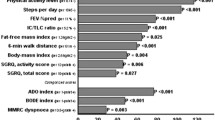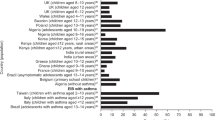Abstract
Objective
International guidelines recommend short- (SABA) or long-acting b-agonists for the prevention of bronchoconstriction after exercise (EIB) in patients with exercise-induced asthma (EIA). However, other drugs are still in discussion for the prevention of EIB. We investigated the efficacy of a combination of inhaled sodium cromoglycate and the β-mimetic drug reproterol versus inhaled reproterol alone and both versus inhaled placebo in subjects with exercise-induced asthma (EIA).
Methods
The study aimed to prove the preventive effect of a combination of 1-mg reproterol and 2-mg disodium cromoglycate (DSCG) and its single components vs. placebo, measuring the decrease of FEV1 after a standardized treadmill test in 11 patients with recorded EIA. The study medication was twice as high as those of drugs which are commercially available (e.g., Allergospasmin®, Aarane®).
Results
The results revealed that the combination of reproterol and DSCG was significantly effective against a decrease of FEV1 after a standardized exercise challenge test (ECT) compared to placebo. The short-acting b-agonist reproterol alone had almost the same effectiveness as the combination of reproterol and DNCG. The difference between the combination with DNCG and reproterol alone was less than 10% and insignificant (p 0.48). DNCG alone did not show a difference in the effectiveness compared to placebo.
Conclusion
Prevention of EIA with the combination of reproterol and DSCG or with reproterol only is effective. An exclusive recommendation in favor of the combination cannot be given due to the low difference in the effectiveness versus reproterol alone. Due to the limited number of subjects and some probands showing protection under DSCG, it cannot be completely excluded that there is some preventive power of DSCG in individual cases.

Similar content being viewed by others
References
Shaaban R, Leynaert B, Soussan D, Antó JM, Chinn S, de Marco R, Garcia-Aymerich J, Heinrich J, Janson C, Jarvis D, Sunyer J, Svanes C, Wjst M, Burney PG, Neukirch F, Zureik M (2007) Physical activity and bronchial hyperresponsiveness: European Community Respiratory Health Survey II. Thorax 62(5):403–410
Weiler JM (1996) Exercise-induced asthma: a practical guide to definitions, diagnosis, prevalence, and treatment. Allergy Asthma Proc 17(6):315–325
Anderson SD (2008) Provocative challenges to help diagnose and monitor asthma: exercise, methacholine, adenosine, and mannitol. Curr Opin Pulm Med 14(1):39–45
Weiler JM, Bonini S, Coifman R, Craig T, Delgado L, Capão-Filipe M, Passali D, Randolph C, Storms W (2007) American Academy of Allergy, Asthma & Immunology Work Group report: exercise-induced asthma. J Allergy Clin Immunol 119(6):1349–1358
Anderson SD (2006) How does exercise cause asthma attacks? Curr Opin Allergy Clin Immunol 6(1):37–42
Wilkerson LA (1998) Exercise-induced asthma. J Am Osteopath Assoc 98(4):211–215
Wenzel SE (2006) Asthma: defining of the persistent adult phenotypes. Lancet 368(9537):804–813
King CS, Moores LK (2008) Clinical asthma syndromes and important asthma mimics. Respir Care 53(5):568–580, discussion 580–2
Park C, Stafford C, Lockette W (2008) Exercise-induced asthma may be associated with diminished sweat secretion rates in humans. Chest 134(3):552–558
Kitch BT, Paltiel AD, Kuntz KM, Dockery DW, Schouten JP, Weiss ST, Fuhlbrigge AL (2004) A single measure of FEV1 is associated with risk of asthma attacks in long-term follow-up. Chest 126(6):1875–1882
Joos GF, O’Connor B, Anderson SD, Chung F, Cockcroft DW, Dahlén B, DiMaria G, Foresi A, Hargreave FE, Holgate ST, Inman M, Lötvall J, Magnussen H, Polosa R, Postma DS, Riedler J (2003) Indirect airway challenges. Eur Respir J 21(6):1050–1068
Anderson SD, Kippelen P (2005) Exercise-induced bronchoconstriction: pathogenesis. Curr Allergy Asthma Rep 5(2):116–122
Hancox RJ, Subbarao P, Kamada D, Watson RM, Hargreave FE, Inman MD (2002) Beta2-agonist tolerance and exercise-induced bronchospasm. Am J Respir Crit Care Med 165(8):1068–1070
Philip G, Williams-Herman D, Patel P, Weinstein SF, Alon A, Gilles L, Tozzi CA, Dass SB, Reiss TF (2007) Protection against exercise-induced bronchoconstriction two hours after a single oral dose of montelukast. J Asthma 44(3):213–217
Tan RA, Spector SL (2002) Exercise-induced asthma: diagnosis and management. Ann Allergy Asthma Immunol 89(3):226–235
McFadden ER Jr, Gilbert IA (1994) Exercise-induced asthma. N Engl J Med 330(19):1362–1367
Konig P, Hordvik NL, Kreutz C (1987) The preventive effect and duration of action of nedocromil sodium and cromolyn sodium on exercise-induced asthma (EIA) in adults. J Allergy Clin Immunol 79(1):64–68
de Benedictis FM, Vaccher S, de Benedictis D (2008) Montelukast sodium for exercise-induced asthma. Drugs Today (Barc) 44(11):845–855
Debelic M, Hertel G, Konig J (1988) Double-blind crossover study comparing sodium cromoglycate, reproterol, reproterol plus sodium cromoglycate, and placebo in exercise-induced asthma. Ann Allergy 61(1):25–29
von Berg A (2002) Intraindividuelle, randomisierte Doppelblindstudie zum Vergleich des protektiven Effektes; zwischen verschiedenen Anwendungsformen von DNCG und reproterol bei Kindern mit Anstrengungsasthma. Allergologie 11:557–564
Sterk PJ, Fabbri LM, Quanjer PH, Cockcroft DW, O’Byrne PM, Anderson SD, Juniper EF, Malo JL (1993) Airway responsiveness. Standardized challenge testing with pharmacological, physical and sensitizing stimuli in adults. Report Working Party Standardization of Lung Function Tests, European Community for Steel and Coal. Official Statement of the European Respiratory Society. Eur Respir J Suppl 16:53–83
Miller MG, Weiler JM, Baker R, Collins J, D’Alonzo G (2005) National Athletic Trainers’ Association position statement: management of asthma in athletes. J Athl Train 40(3):224–245
Fleiss JL (1986) The design and analysis of clinical experiments. John Wiley & Sons, New York
Anderson SD, Caillaud C, Brannan JD (2006) Beta2-agonists and exercise-induced asthma. Clin Rev Allergy Immunol 31(2–3):163–180
Pearlman DS, Rees W, Schaefer K, Huang H, Andrews WT (2007) An evaluation of levalbuterol HFA in the prevention of exercise-induced bronchospasm. J Asthma 44(9):729–733
Lecheler J (2008) Prevention of exercise-induced asthma by a fixed combination of disodium cromoglycate plus reproterol compared with montelukast in young patients. Arzneimittelforschung 58(6):303–309
Kanniess F, Jorres RA, Magnussen H (2005) Effect of reproterol either alone or combined with disodium cromoglycate on airway responsiveness to methacholine. Pulm Pharmacol Ther 18(5):315–320
Kelly KD, Spooner CH, Rowe BH (2001) Nedocromil sodium versus sodium cromoglycate in treatment of exercise-induced bronchoconstriction: a systematic review. Eur Respir J 17(1):39–45
Abholz HH (2011) Nationale Versorgungsleitlinie Asthma.; 2nd Ed.: Available from: http://www.versorgungsleitlinien.de/themen/asthma (accessed 14.03.2011)
Dryden DM, Spooner CH, Stickland MK, Vandermeer B, Tjosvold L, Bialy L, Wong K, Rowe BH (2010) Exercise-induced bronchoconstriction and asthma. Evid Rep Technol Assess (Full Rep) 189:1–154, v-vi
Miller MR, Hankinson J, Brusasco V, Burgos F, Casaburi R, Coates A, Crapo R, Enright P, van der Grinten CP, Gustafsson P, Jensen R, Johnson DC, MacIntyre N, McKay R, Navajas D, Pedersen OF, Pellegrino R, Viegi G, Wanger J, ATS/ERS Task Force (2005) Standardisation of spirometry. Eur Respir J 26(2):319–38
Reddel HK (2009) Characterizing asthma phenotypes: predictors and outcomes at the extremes of asthma severity. Respirology 14(6):778–780
Higgs CM, Laszlo G (1983) The duration of protection from exercise-induced asthma by inhaled salbutamol, and a comparison with inhaled reproterol. Br J Dis Chest 77(3):262–269
Author information
Authors and Affiliations
Corresponding author
Rights and permissions
About this article
Cite this article
Küpper, T., Goebbels, K., Kennes, L.N. et al. Cromoglycate, reproterol, or both—what’s best for exercise-induced asthma?. Sleep Breath 16, 1229–1235 (2012). https://doi.org/10.1007/s11325-011-0638-2
Received:
Revised:
Accepted:
Published:
Issue Date:
DOI: https://doi.org/10.1007/s11325-011-0638-2




